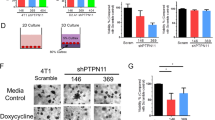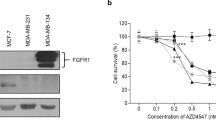Abstract
p38 belongs to a family of mitogen-activated protein kinases, which transfer extracellular signals into intracellular responses. p38 is also frequently detected in clinical breast cancer specimens, but its role as a prognostic factor is not known. Of the various p38 isoforms, p38β has been shown to mediate the in vitro invasiveness of breast cancer cells through up-regulation of urokinase plasminogen activator (uPA). We studied the role of p38β in breast cancer bone metastases, using dominant negative blockade approach. Human MDA-MB-231 breast cancer clones stably expressing dominant negative p38β (p38/AF) exhibited decreased basal MMP-9 activity. TGF-β 1-induced MMP-9 activity was also blunted in these clones, as compared with controls in which TGF-β 1 up-regulated MMP-9 activity. Consistent with these findings, SB202190, a specific p38 inhibitor, also inhibited TGF-β1-induced MMP-9 activity in parental cells. The p38/AF clones exhibited also reduced uPA production after growth on vitronectin and decreased cell motility, as compared with controls. VEGF production levels in all the studied clones were similar. The p38/AF clone, which had similar in vitro growth rate as the control pcDNA3 clone, formed significantly less bone metastases in a mouse model, as compared with the control clone. In conclusion, inhibition of the p38β pathway results in decreased MMP-9 activity, impaired uPA expression and decreased motility, all of which may contribute to the decreased formation of bone metastasis.
Similar content being viewed by others
References
Coleman RE. Skeletal complications of malignancy. Cancer1997: 80(Suppl 8): 1588–94.
Galasko CS, Bennett A. Relationship of bone destruction in skeletal metastases to osteoclast activation and prostaglandins. Nature 1976; 263(5577): 508–10.
Chambers AF, Groom AC, MacDonald IC. Dissemination andgrowth of cancer cells in metastatic sites. Nat Rev Cancer 2002; 2(8): 563–72.
Egeblad M, Werb Z. New functions for the matrix metallopro-teinases in cancer progression. Nat Rev Cancer 2002; 2(3): 161–74.
Mastro AM, Gay CV, Welch DR. The skeleton as a uniqueenvironment for breast cancer cells. Clin Exp Metast 2003; 20(3): 275–84.
Yoneda T. Arterial microvascularization and breast cancer colonization in bone. Histol Histopathol 1997; 12(4): 1145–9.
Muller A, Homey B, Soto H et al. Involvement of chemokine receptors in breast cancer metastasis. Nature 2001; 410(6824): 50–6.
Kang Y, Siegel PM, Shu W et al. A multigenic program medi-ating breast cancer metastasis to bone. Cancer Cell 2003:3(6):537–49.
Guise TA, Yin JJ, Taylor SD et al. Evidence for a causal roleof parathyroid hormone-related protein in the pathogenesis ofhuman breast cancer-mediated osteolysis. J Clin Invest. 1996 98(7): 1544–9.
Han J, Lee JD, Bibbs L et al. A MAP kinase targeted by endo-toxin and hyperosmolarity in mammalian cells. Science 1994; 265(5173): 808–11.
Nebreda AR, Porras A. p38 MAP kinases: beyond the stressresponse. Trends Biochem Sci 2000; 25(6): 257–60.
Mueller H, Flury N, Eppenberger-Castori S et al. Potentialprognostic value of mitogen-activated protein kinase activity fordisease-free survival of primary breast cancer patients. Int JCancer 2000; 89(4): 384–8.
Esteva FJ, Hortobagyi GN, Sahin AA et al. Expression oferbB/HER receptors, heregulin and p38 in primary breast cancer using quantitative immunohistochemistry. Pathol Oncol Res 2001: 7(3): 171–7.
Wang HY, Cheng Z, Malbon CC. Overexpression of mitogen-activated protein kinase phosphatases MKP1, MKP2 in humanbreast cancer. Cancer Lett 2003; 191(2): 229–37.
Pramanik R, Qi X, Borowicz S et al. p38 isoforms have oppo-site effects on AP-1-dependent transcription through regulationof c-Jun. The determinant roles of the isoforms in the p38 MAPK signal specificity. J Biol Chem 2003; 278(7): 4831–9.
Zhang CC, Shapiro DJ. Activation of the p38 mitogen-acti-vated protein kinase pathway by estrogen or by 4-hydroxytam-oxifen is coupled to estrogen receptor-induced apoptosis. J BiolChem 2000; 275(1): 479–86.
Cocolakis E, Lemay S, Ali S et al. The p38 MAPK pathway isrequired for cell growth inhibition of human breast cancer cellsin response to activin. J Biol Chem 2001; 276(21): 18430–6.
Xiong S, Grijalva R, Zhang L et al. Up-regulation of vascularendothelial growth factor in breast cancer cells by theheregulin-beta1-activated p38 signaling pathway enhances endo-thelial cell migration. Cancer Res 2001; 61(4): 1727–32.
Montero L, Nagamine Y. Regulation by p38 mitogen-activatedprotein kinase of adenylate-and uridylate-rich element-medi-ated urokinase-type plasminogen activator (uPA) messengerRNA stability and uPA-dependent in vitro cell invasion. CancerRes 1999; 59(20): 5286–93.
Huang S, New L, Pan Z et al. Urokinase plasminogen activa-tor/urokinase-speci c surface receptor expression and matrixinvasion by breast cancer cells requires constitutive p38alphamitogen-activated protein kinase activity. J Biol Chem 2000; 275(16): 12266–72.
Chen J, Baskerville C, Han Q et al. Alpha(v) integrin, p38mitogen-activated protein kinase, and urokinase plasminogenactivator are functionally linked in invasive breast cancer cells. J Biol Chem 2001; 276(51): 47901–5.
Han Q, Leng J, Bian D et al. Rac1-MKK3-p38-MAPKAPK2pathway promotes urokinase plasminogen activator mRNA sta-bility in invasive breast cancer cells. J Biol Chem 2002; 277(50): 48379–85.
Mansky KC, Sankar U, Han J et al. Microphthalmia transcrip-tion factor is a target of the p38 MAPK pathway in response toreceptor activator of NF-kappa B ligand signaling. J Biol Chem2002; 277(13): 11077–83.
Suarez-Cuervo C, Harris KW, Kallman L et al. Tumor necrosisfactor-alpha induces interleukin-6 production via extracellular-regulated kinase 1 activation in breast cancer cells. Breast Cancer Res Treat 2003; 80(1): 71–8.
Kim MS, Lee EJ, Kim HR et al. p38 kinase is a key signaling mol-ecule for H-Ras-induced cell motility and invasive phenotype inhuman breast epithelial cells. Cancer Res 2003; 63(17): 5454–61.
Arguello F, Baggs RB, Frantz CN. A murine model of experi-mental metastasis to bone and bone marrow. Cancer Res 1988; 48(23): 6876–81.
Farina AR, Coppa A, Tiberio A et al. Transforming growthfactor-beta1 enhances the invasiveness of human MDA-MB-231breast cancer cells by up-regulating urokinase activity. Int JCancer 1998; 75(5): 721–30.
Yu L, Hebert MC, Zhang YE. TGF-beta receptor-activated p38 MAP kinase mediates Smad-independent TGF-beta responses. EMBO J 2002; 21(14): 3749–59.
Duivenvoorden WC, Hirte HW, Singh G. Transforming growthfactor beta1 acts as an inducer of matrix metalloproteinaseexpression and activity in human bone-metastasizing cancercells. Clin Exp Metastasis 1999; 17(1): 27–34.
Selvamurugan N, Fung Z, Partridge NC. Transcriptional acti-vation of collagenase-3 by transforming growth factor-beta1 isvia MAPK and Smad pathways in human breast cancer cells. FEBS Lett 2002; 532(1–2): 31–5.
Tsunezuka Y, Kinoh H, Takino T et al. Expression of mem-brane-type matrix metalloproteinase (MT1-MMP) in tumorcells enhances pulmonary metastasis in an experimental metas-tasis assay. Cancer Res 1996; 56(24): 5678–83.
Matsumoto T, Yokote K, Tamura K et al. Platelet-derivedgrowth factor activates p38 mitogen-activated protein kinasethrough a Ras-dependent pathway that is important for actinreorganization and cell migration. J Biol Chem 1999; 274(20): 13954–60.
Boudreau N, Myers C. Breast cancer-induced angiogenesis: multiple mechanisms and the role of the microenvironment. Breast Cancer Res 2003; 5(3): 140–6.
Tsai PW, Shiah SG, Lin MT et al. Up-regulation of vascularendothelial growth factor C in breast cancer cells by heregulin-beta. A critical role of p38/nuclear factor-kappa B signaling pathway. J Biol Chem 2003; 278(8): 5750–9.
Yamada SD, Hickson JA, Hrobowski Y et al. Mitogen-acti-vated protein kinase kinase 4 (MKK4) acts as a metastasis sup-pressor gene in human ovarian carcinoma. Cancer Res 2002; 62(22): 6717–23.
Yoshida BA, Dubauskas Z, Chekmareva MA et al. Mitogen-activated protein kinase kinase 4/stress-activated protein/Erkkinase (MKK4/SEK1), a prostate cancer metastasis suppres-sor gene encoded by human chromosome. Cancer Res 1999; 59(21): 5483–7.
Su GH, Song JJ, Repasky EA et al. Mutation rate ofMAP2K4/MKK4 in breast carcinoma. Hum Mutat 2002; 19(1): 81.
Ravanti L, Toriseva M, Penttinen R et al. Expression of humancollagenase-3 (MMP-13) by fetal skin broblasts is induced bytransforming growth factor beta via p38 mitogen-activated pro-tein kinase. FASEB J 2001; 15(6): 1098–100.
Leivonen SK, Chantry A, Ha¨kkinen L et al. Smad3 mediatestransforming growth factor-beta-induced collagenase-3 (matrixmetalloproteinase-13) expression in human gingival broblasts. Evidence for cross-talk between Smad3 and p38 signaling path-ways. J Biol Chem 2002; 277(48): 46338–46.
Fisher JL, Field CL, Zhou H et al. Urokinase plasminogen acti-vator system gene expression is increased in human breast carci-noma and its bone metastases–a comparison of normal breasttissue, non-invasive and invasive carcinoma and osseous metas-tases. Breast Cancer Res Treat 2000; 61(1): 1–12.
Wang Y. The role and regulation of urokinase-type plasmino-gen activator receptor gene expression in cancer invasion andmetastasis. Med Res Rev 2001; 21(2): 146–70.
Lee J, Weber M, Mejia S et al. A matrix metalloproteinaseinhibitor, batimastat, retards the development of osteolytic bonemetastases by MDA-MB-231 human breast cancer cells in BalbC nu/nu mice. Eur J Cancer 2001; 37(1): 106–13.
Sun Y, Cheng Z, Ma L et al. Beta-arrestin2 is criticallyinvolved in CXCR4-mediated chemotaxis, and this is mediatedby its enhancement of p38 MAPK activation. J Biol Chem 2002; 277(51): 49212–9.
Woods Ignatowski KM, Grewal NK, Markwart S et al. p38MAPK induces cell surface a integrin downregulation tofacilitate erbB-2-mediated invasion. Neoplasia 2003;5(2): 128–34.
Ka ¨ko ¨nen SM, Mundy GR. Mechanisms of osteolytic bonemetastases in breast carcinoma. Cancer 2003; 97(Suppl 3): 834-9.
Winding B, Misander H, Sveigaard C et al. Human breast can-cer cells induced angiogenesis, recruitment, and activation ofosteoclasts in osteolytic metastasis. J Cancer Res Clin Oncol. 2000; 126(11): 631–40.
Donovan D, Harmey JH, Toomey D et al. TGF beta-1 regula-tion of VEGF production by breast cancer cells. Ann SurgOncol 1997; 4(8): 621–7.
Li A, Dubey S, Varney ML et al. IL-8 directly enhanced endo-thelial cell survival, proliferation, and matrix metalloproteinasesproduction and regulated angiogenesis. J Immunol 2003; 170(6): 3369–76.
Ma DH, Chen JI, Zhang F et al. Inhibition of broblast-induced angiogenic phenotype of cultured endothelial cells bythe overexpression of tissue inhibitor of metalloproteinase(TIMP)-3. J Biomed Sci 2003; 10(5): 526–34.
Author information
Authors and Affiliations
Rights and permissions
About this article
Cite this article
Suarez-Cuervo, C., Merrell, M.A., Watson, L. et al. Breast cancer cells with inhibition of p38α have decreased MMP-9 activity and exhibit decreased bone metastasis in mice. Clin Exp Metastasis 21, 525–533 (2004). https://doi.org/10.1007/s10585-004-3503-x
Issue Date:
DOI: https://doi.org/10.1007/s10585-004-3503-x




